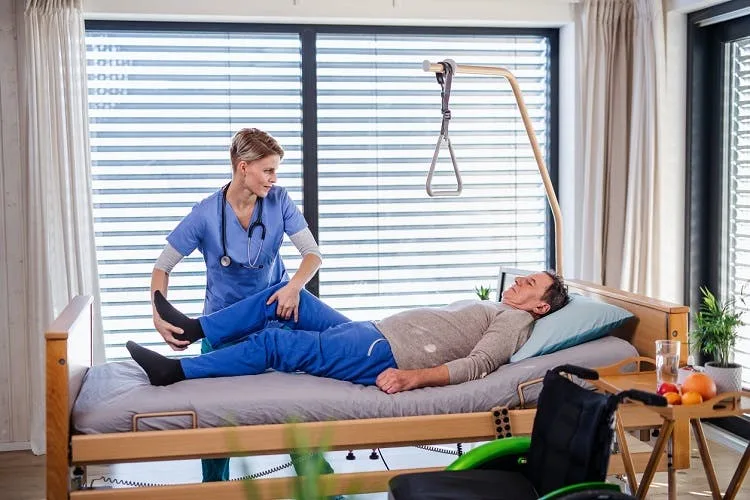Understanding Bed Mobility
Bed mobility is a fundamental aspect of daily living that often goes unnoticed until it becomes a challenge. It refers to the ability to move around in bed, including actions like rolling, sitting up, and transferring to and from the bed. This seemingly simple skill is essential for independence and overall quality of life.
Why Bed Mobility Exercises Matter?
Being bedridden can lead to a rapid decline in physical health. Muscle atrophy, joint stiffness, and poor circulation are common issues that can arise. Bed mobility exercises are designed to combat these problems by keeping the body active and engaged, even while confined to bed.
- Independence: Strong bed mobility empowers individuals to perform self-care tasks without relying on others.
- Reduced Risk of Injury: Improved bed mobility can help prevent falls and injuries associated with bed transfers.
- Enhanced Comfort: The ability to reposition oneself in bed can alleviate pressure points and improve comfort.
- Faster Recovery: For those recovering from illness or injury, effective bed mobility can expedite the healing process.
Key Muscle Groups Involved in Bed Mobility
- Core Muscles: These include the abdominals and back muscles, which provide stability and strength.
- Hip Flexors: These muscles help to bend the hips and initiate movement.
- Shoulder Muscles: The deltoids and rotator cuff muscles are essential for upper body strength and mobility.
- Leg Muscles: The quadriceps, hamstrings, and calf muscles are crucial for leg strength and flexibility.
Bed mobility exercises are crucial for individuals who spend extended periods in bed due to illness, injury, or surgery. These exercises help maintain muscle strength, improve circulation, and prevent complications such as pressure sores and joint stiffness. In this article, we’ll explore seven essential bed mobility exercises that can significantly enhance your quality of life.
Essential Bed Mobility Exercises
1. Ankle Pumps
How to Do It:
- Lie on your back with your legs straight.
- Flex your ankles, pulling your toes toward your head.
- Point your toes away from your head.
- Repeat 10-15 times.
Benefits: Ankle pumps help improve blood circulation in the lower legs, reducing the risk of blood clots and swelling.
2. Knee Bends
How to Do It:
- Lie on your back with your legs straight.
- Bend one knee, sliding your heel toward your buttocks.
- Straighten your leg back to the starting position.
- Repeat 10-15 times on each leg.
Benefits: Knee bends help maintain flexibility in the knee joints and strengthen the quadriceps.
3. Leg Lifts
How to Do It:
- Lie on your back with one leg bent and the other straight.
- Lift the straight leg to about 12 inches off the bed.
- Hold for a few seconds, then lower it back down.
- Repeat 10-15 times on each leg.
Benefits: Leg lifts strengthen the hip flexors and quadriceps, improving overall leg strength.
4. Glute Bridges
How to Do It:
- Lie on your back with your knees bent and feet flat on the bed.
- Lift your hips toward the ceiling, squeezing your glutes.
- Hold for a few seconds, then lower your hips back down.
- Repeat 10-15 times.
Benefits: Glute bridges strengthen the glutes and lower back muscles, enhancing stability and support.
5. Arm Lifts
How to Do It:
- Lie on your back with your arms at your sides.
- Lift one arm toward the ceiling, keeping it straight.
- Lower it back down and repeat with the other arm.
- Repeat 10-15 times on each arm.
Benefits: Arm lifts help maintain shoulder mobility and strengthen the upper body.
6. Side Rolls
How to Do It:
- Lie on your back with your knees bent.
- Roll your body to one side, using your arms to assist.
- Hold for a few seconds, then roll back to the starting position.
- Repeat 10-15 times on each side.
Benefits: Side rolls improve core strength and help with overall body coordination.
7. Neck Stretches
How to Do It:
- Lie on your back with your head supported by a pillow.
- Gently turn your head to one side, holding for a few seconds.
- Turn your head to the other side and hold.
- Repeat 10-15 times on each side.
Benefits: Neck stretches help relieve tension and improve flexibility in the neck muscles.
Tips for Improving Bed Mobility
- Consult with a Healthcare Professional: Before starting any new exercise routine, it’s essential to consult with a physical therapist or healthcare provider.
- Listen to Your Body: Pay attention to any pain or discomfort and adjust your exercises accordingly.
- Be Consistent: Regular practice is key to improving bed mobility. Aim for daily exercises or as often as your schedule allows.
- Stay Hydrated: Drink plenty of water to stay hydrated and support muscle function.
- Incorporate Bed Mobility into Daily Activities: Practice rolling, sitting up, and transferring in and out of bed throughout the day.
- Use Assistive Devices: If needed, consider using assistive devices like bed rails, transfer boards, or a sliding board to aid in bed mobility.
Conclusion
Incorporating these bed mobility exercises into your daily routine can significantly improve your physical health and overall well-being. By staying active, even while bedridden, you can maintain muscle strength, improve circulation, and prevent complications. Remember to consult with a healthcare provider before starting any new exercise regimen to ensure it’s safe for your specific condition.
